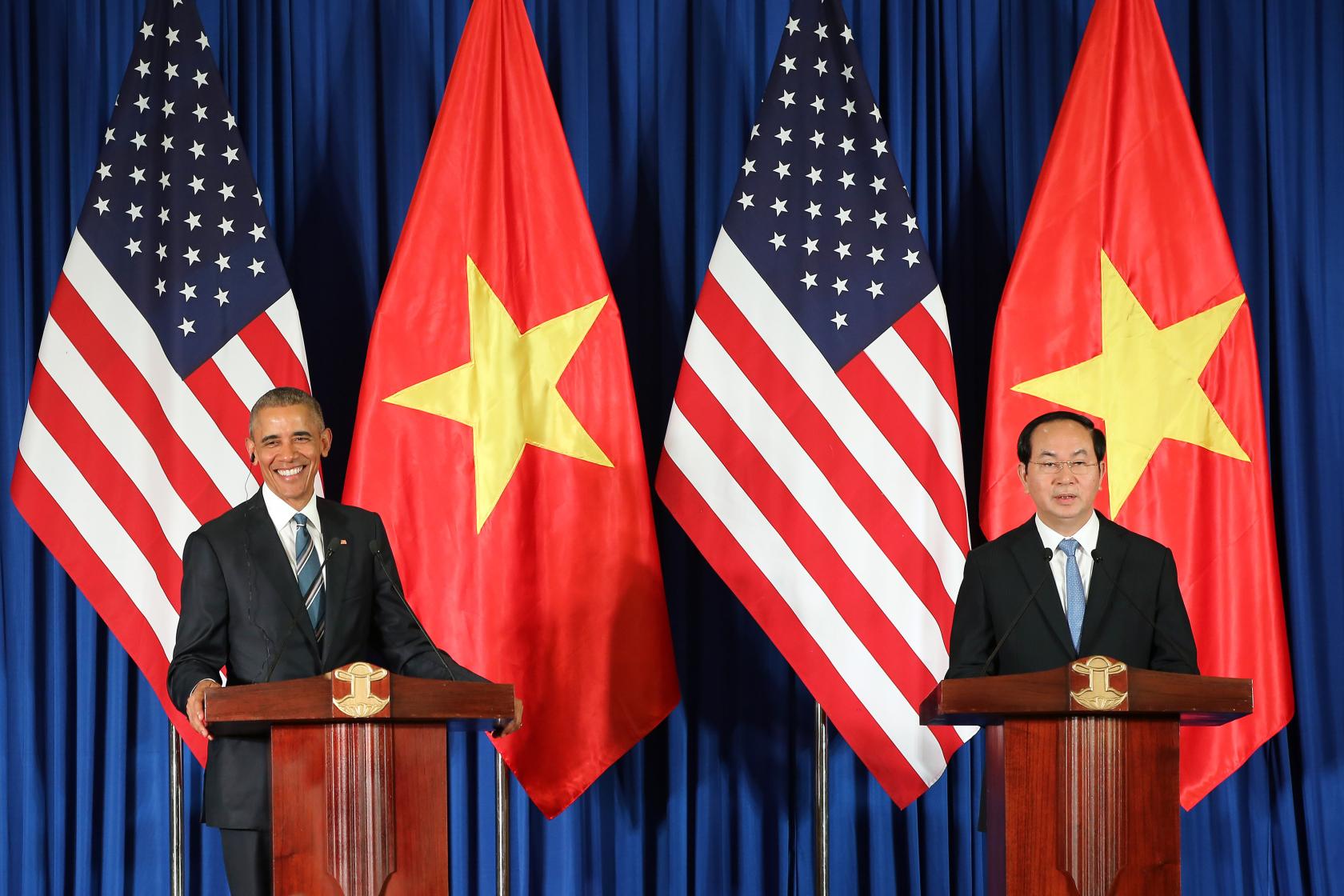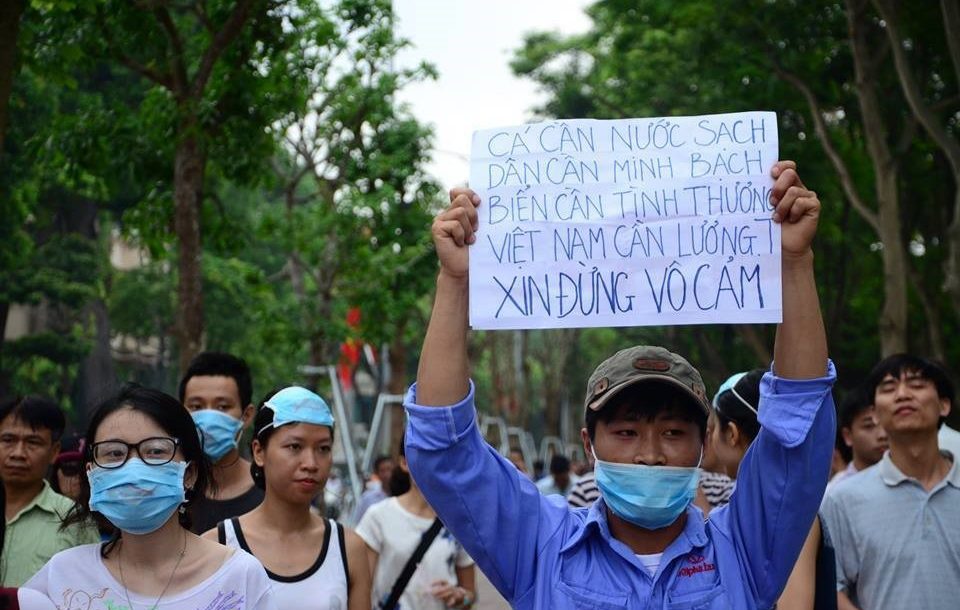Angie Tran explores what the the US/Vietnam Labor Side Agreement means for workers’ rights in Vietnam.
On the eve of President Obama’s visit to Vietnam, let’s ponder what the US/Vietnam Labor Side Agreement (TPP/LSA), entitled “United States-Viet Nam Plan for the Enhancement of Trade and Labor Relations,” means to workers. How can the LSA empower workers in this neo-liberal context? What does “freedom of association and the right to organize and collective bargaining” (ILO Labor Standard conventions #87 and #98) mean to workers, if the agreement is ratified in both countries?
First, changes to the Vietnam’s labor laws had already been made, before the TPP/LSA, which have the effect of punishing strikers and weakening union leadership. Decree No. 05/2015/ND-CP (to implement the Labor Code) demands that strikes be resolved within 24 hours, with potential fines on strikers and union representatives who lead “illegal” strikes. Article 35 on “Handling of labor strikes that do not follow the regulatory procedures” aims to deter workers from collective action: they will not be paid salary and benefits for the time they participate in strikes. Article 36 on “Compensation for damage caused by illegal strikes” discourages union leadership from being involved in strikes, because the employer can calculate damages and costs incurred in strikes and request the organizing unions to pay compensation.
Section II-G, “Scope of strikes” in the TPP/LSA, appears to broaden the scope of strikes by allowing both rights-based (currently proscribed in the Labor Code) and interests-based [permitted in the LC Article 215(1)].[1] But given the restrictions arising from Decree No. 05/2015/ND-CP (Article 35 and 36), it is important to redefine “illegal” strikes to ensure that labor organizing itself is empowered by this broadened scope of strikes.
Second, the right to organize labor unions independent of the Vietnamese General Confederation of Labor (VGCL) in Section II-A1 is vague. What is the “competent government body” charged with registering a grassroots labor union? There are no protections for those who organize the competing unions or for the workers who join these new labor organizations. The government has been accusing attempts at organizing outside the VGCL as fronts for anti-government groups. What protections does the TPP/LSA offer these workers and organizers?

Third, the VGCL has been engaging in a strategic planning mode to maintain its power. Some competition (from ILO conventions #87 and #98) to improve the VGCL effectiveness in representing workers is not a bad idea. The recent minimum wage increase for 2016 demonstrates that the VGCL had failed to negotiate for even a subsistence level increase of the minimum wage: it is the lowest since 2013.[2] While fighting hard on workers’ behalf, they lost this fight due to an alliance between management and the National Wage Council. Also, it is important for the VGCL to provide training for workers—most do not know much about the TPP/LSA—to understand their labor rights if/when the agreement is ratified.
Fourth, workers need livable wage, not minimum wage, as promised by Article 91 of the Labor Code: “minimum wage, as the lowest level to pay simple labor, must cover at least the subsistence level [livable wage] of workers and their families” (Labor Code 2012, p. 19). Workers have been suffering because their wages are not livable. They live without having enough food to eat, living in substandard housing, shopping for cheap snacks on the streets in the morning to last the whole day, and working until they drop to make ends meet for their families (see the dozens of Vietnamese newspaper articles published in the months leading up to the decisive minimum wage meeting on September 3, 2015). The challenge for the “independent labor unions” should be to demand and win a “living wage” for workers, which is promised to them in the present Labor Code and included in many multi-firm stakeholder codes such as SA8000 and Worker Rights Council.
Fifth, the TPP/LSA should demand that US MNCs, who place orders with their FDI supplier factories in Vietnam, pay a “livable wage,” not the minimum wage, to millions of Vietnamese workers making shoes and products for Americans. Wage issues directly connect to social insurance benefits (2014 Social Insurance Law, Article 89). They should pressure their suppliers to pay higher social insurance premiums based on the actual, higher gross salary, as will be mandatory by law in 2018. For decades, these companies have been able to shirk their responsibilities, underfunding social insurance while maintaining the high profit margins for their MNCs.[5]
Finally, the TPP/LSA needs to have strong enforcement mechanisms to enforce its labor standards and environmental rights. The ongoing massive fish kill and environmental crisis since April 2016 in the central provinces is a direct occupational, safety and health violation which should be avoided with strong labor mobilization to protect fishing communities, workers and the Vietnamese society at large.
Time is of the essence. It will take at least until 2020 (five years after Vietnam signs the TPP Agreement with the United States, if it is ratified in 2017) for any of these changes to take effect. During that time, how can workers in factories without enterprise-level labor unions engage in strikes, especially with Decree No. 05/2015/ND-CP pre-emption? A transitional mechanism is needed to empower the workers, given a current lack of effective union representation for labor rights. For example, workers need whistleblower protection to report labor and environmental violations to the media or global impartial monitors who come to inspect their factories on codes of conduct compliance. As a last resort, grassroots worker organizations should be able to appeal directly to the Labor Expert Committee or to use the TPP Dispute Settlement mechanism when other venues are blocked or censored.
Angie Ngoc Tran is Professor of Political Economy, at California State University, Monterey Bay.
END NOTES
[1] Section G. Scope of strikes: 1. Viet Nam shall ensure that its law allows for rights-based strikes, consistent with ILO guidance. Relevant articles in current law include LC Article 215(1).
[2] 29.5% (2013); 22.9% (2014); 14.3% (2015), and only 12.4% for 2016. Consequently, the 2016 monthly minimum wages in metropolitan areas (such as Ho Chi Minh City and Hanoi) are: $159/month (top rate, yes, per month), and in rural areas: $109/month. These monthly salaries can cover only about 75% of basic necessities for workers.
[3]Angie Ngoc Tran, Critical Perspective on Multi-stakeholder Framework in Contemporary Vietnamese State-Labor-Management Relations, in Routledge Handbook of Contemporary Vietnam, edited by Jonathan London, et al., forthcoming in 2016
 Facebook
Facebook  Twitter
Twitter  Soundcloud
Soundcloud  Youtube
Youtube  Rss
Rss 